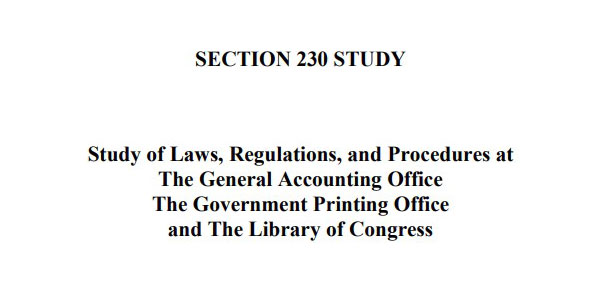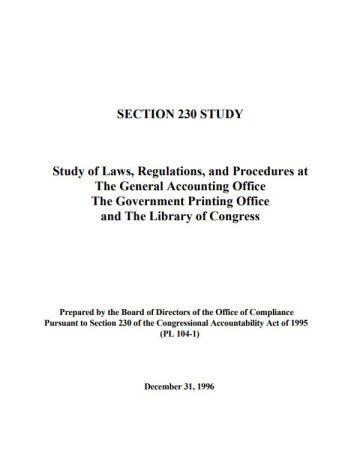EXECUTIVE SUMMARY
Section 230 of the Congressional Accountability Act of 1995 (CAA) mandates a study of the application of the laws listed in section 230(b) to the General Accounting Office (GAO), Government Printing Office (GPO) and Library of Congress (the Library) (referred to collectively as the instrumentalities).1 Originally, section 230 directed the Administrative Conference of the United States (ACUS) to conduct the study but, in connection with the dissolution of ACUS in November of 1995, the law was amended to transfer responsibility for the study to the Board of Directors of the Office of Compliance.2
The study is organized into three sections which, as required by section 230(a), review the application of laws, regulations, and procedures to each instrumentality and, as required under section 230(c), evaluate whether these rights, protections, and procedures (including administrative and judicial relief) are “comprehensive and effective.” Because the CAA does not define the phrase “comprehensive and effective,” the Board has found guidance in two other sections of the statute, as well as the legislative history, in determining what the phrase “comprehensive and effective” should be understood to mean. These sources all use the CAA as their benchmark, suggesting that “comprehensive and effective” in the section 230 context is also best understood in comparison to the CAA.
Section 505 of the CAA directs the Judicial Conference of the United States to report on the application to the judicial branch of the eleven laws made applicable by the CAA, and to include any recommendations to grant to employees of the judicial branch rights, protections, procedures, and relief under those laws “that are comparable to those available to employees in the legislative branch under [the CAA].”3 This direction suggests a statutory interest in parity in the application of the eleven laws to agencies in the legislative and in the judicial branches. Additionally, section 102(b)(2) requires the Board to report on whether other provisions of laws relating to employment and public access, in addition to those incorporated into the CAA, should be made applicable to the legislative branch. That the CAA separately requires the Board to make proposals about extensions of the CAA suggests that, for these purposes, the CAA is the appropriate point of comparison.
The legislative history of section 230 also suggests using the CAA as the reference point. The section-by-section analysis placed in the record by Senator Grassley on behalf of himself and Senator Lieberman makes clear their expectation that the report would use the CAA to evaluate comprehensiveness and effectiveness: “This study should evaluate not only the extent to which employees are provided the rights and protections of the laws made applicable to Congress in this act. But also whether they are as comprehensive and effective as those provided under this act.”1 Similar views were expressed by committees of the House and Senate during the 103rd Congress in reports on bills similar to the CAA.2 Accordingly, for purposes of this 230(b) study, the Board has interpreted the phrase “comprehensive and effective” to mean comprehensive and effective when compared with the rights, protections, procedures, and relief afforded under the CAA.
In evaluating the comprehensiveness and effectiveness of the rights, protections and procedures available to the instrumentalities, the Board reviewed the following key aspects of the current statutory and regulatory regimes: (1) the nature of the substantive rights and protections afforded to employees, both as guaranteed by statute and as applied by rules and regulations; (2) the adequacy of administrative processes, including: (a) adequate enforcement mechanisms for monitoring compliance and detecting and correcting violations, and (b) a fair and independent mechanism for informally resolving or, if necessary, investigating, adjudicating, and appealing disputes; (3) the availability and adequacy of judicial processes and relief; and (4) the adequacy of any process for issuing substantive regulations specific to an instrumentality, including proposal and adoption by an independent regulatory authority under appropriate statutory criteria. The Board’s purpose in doing so is to fully explicate the issues of concern in section 230(c).
Section 230(c) also states that the study should “include recommendations for any improvements in regulations or legislation, including proposed regulatory or legislative language.” Section 230(c) originally required ACUS to “prepare and complete the study and recommendations” and then “submit the study and recommendations to the Board.”3 The Board, in turn, was to “transmit such study and recommendations (with the Board’s comments)” to the instrumentalities and the Congress.4 Thus, the Board’s role as commentator was, quite literally, parenthetical. After the dissolution of ACUS, Congress transferred the responsibility for conducting the study and making recommendations from ACUS to the Board. The Board’s institutional role, functions, and resources are vastly different from those of ACUS and, therefore, these differences must necessarily reshape the contours of the study.

